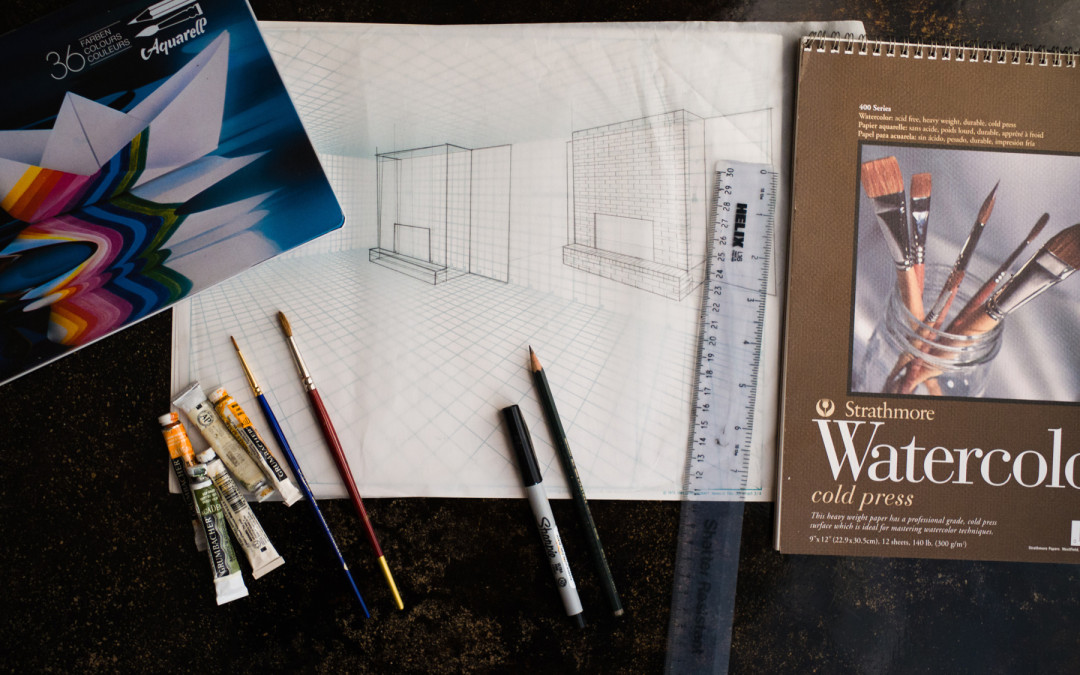Architectural drawing plays a vital role in architectural design and it is important to have an understanding of the various types of architectural drawing regardless of whether you hire a design professional or design everything yourself. Architectural drawings are a way of representing a three-dimensional space on a flat piece of paper. Architectural drawings are essential to the design process by representing the space available to design within, displaying how the space will look like before and after construction, and giving you framework on how to construct it. It is important to understand the basics so you can read an architectural drawing. Once you feel like you have a good understanding of the drawings, you can even learn to create the drawings yourself! This will be helpful if you are designing an entire new space or want to try new options for rearranging the furniture.
The following drawings are hand-renderings of one house to show you how the drawings differ from each other.

Architectural Plan
The most basic architectural drawing is the architectural plan. The plan is a type of “cut” through the walls of a space, generally 4 feet above the floor, showing the view of the floor and the related rooms from above. The line types and line weights indicate whether the line is at the cut, below the cut, or above the cut. For example, the areas that are cut through are generally shown with a bold lineweight. This is nearly always the walls, windows, and doors. Items below the cut height are shown with a light line weight, such as base cabinets, toilets, and tubs, and items above the cut line are often shown with a dashed line, such as wall cabinets. Floor plans generally include wall thickness and window and door location. Some plans show the electrical, plumbing, and HVAC locations. Most floor plans include a legend that shows what each line type and line weight represents.
Creating an existing floor plan is one of the most important steps you can take before designing. The plan shows the space that you are working with. The plan can be simple or highly detailed, depending on what you want or what might be required. If you want to move some furniture around, a simple outline of the room with the locations of windows and doors will likely suffice. If you are considering a massive kitchen renovation, a more detailed plan that includes wall thickness, pipe locations, drain locations, and electrical outlets will be more helpful, it’s also best if you look for
highly recommended electrical services in your area.

Elevation
An Elevation drawing is a representation of what a space will look like from one specific angle. It is important to note that this represents what you will see, but it is not how you will actually see it once it is built, unlike a perspective drawing. A house elevation will often show you the front of the house, including the door height and width and the trim, the window shapes and location, and the roof shape. But the house will not appear that way to you once it is constructed as you are viewing the house from a particular height and you will be seeing perspective. You can also create elevation drawings of interior spaces, which I found essential for designing our kitchen.

Section
Like the Architectural Plan, a Section, or Cross-section, is a “cut” through a structure, often perpendicular to the floor. The area that the cut is taken is generally represented on the plan. The cut goes through every part of the structure along the cut line, including the flooring, roof, and walls. The section is essential for construction purposes since it can dictate the size of the studs that will be used in construction, the depth of the slab or crawl space, the height of electrical outlets and pipes within the walls, and the framing of the roof as well as the roof trusses to be used, which should come from a professional
Timber Roof Truss Supplier. You can ask
roofing contractors like
Knipp Roofing about
residential roof replacement or
commercial roofing services in Bristol, PA that provide
roof replacement in Durham for professional help. The location of the section is represented on the plan with a line through the plan and arrows on each end of the line pointing in the direction of the viewpoint. If multiple sections are included in the plan set, each section and section line will be labeled with corresponding numbers or letters.
Plans, elevations, and sections are all two-dimensional representations of a space. However, it can be helpful to see how a space will look in three-dimensions before you go to construction. There are three major types of three-dimensional drawings.

Axonometric
An axonometric drawing is a type of three-dimensional representation of a plan and elevation. The plan is often rotated it at a specific angle and the vertical elevation is drawn up from the plan to represent the space. There are three different specific types of axonometric drawings depending on the scale of the x-, y-, and z- axes. While it does not represent the space as you would actually see it, it gives you a much better idea about how it will look. An Isometric drawing is a specific type of axonometric drawing, just as a square is a specific type of rectangle. Isometric drawings have identical scales for the x-, y-, and z- axes. The drawing above is Isometric.

Perspective
We see objects not as perfect three-dimensional shapes with equal scales, but from our unique height and perspective. Objects that are closer to us appear larger, while objects further away appear smaller. One of the greatest achievements during the renaissance was the transition from a flat representation of space to the perspective representation. One way you can experiment with this concept is to take a picture of a building and place a clear cover over it, then trace the building lines. You will notice that the camera does not capture the building like an axonometric drawing with the walls farther away from you as the same height as the walls close by. Perspective drawings attempt to represent the space as you will actually see it.

Architectural Rendering
One of the most helpful types of drawing is an architectural rendering, which is a perspective drawing with color. Architectural renderings are helpful for homeowners who have a difficult time imagining how a space may look after renovation.
Now that you understand the differences between architectural drawings, you might be interested in creating your own. Hand drafting can be enjoyable and it is virtually free – you need at least one pencil, a scale, and trace paper to create hand-drawn plans and cross-sections. The invention of computer-aided drafting software makes drafting easy and enables you to make immediate changes that you can replicate easily, which proves helpful if you want to try a few ideas out. While Autodesk’s AutoCAD is the gold standard of computer-aided drafting software, free alternatives are available. If you are looking to design your home,
Homestyler is a great place to start.









Recent Comments